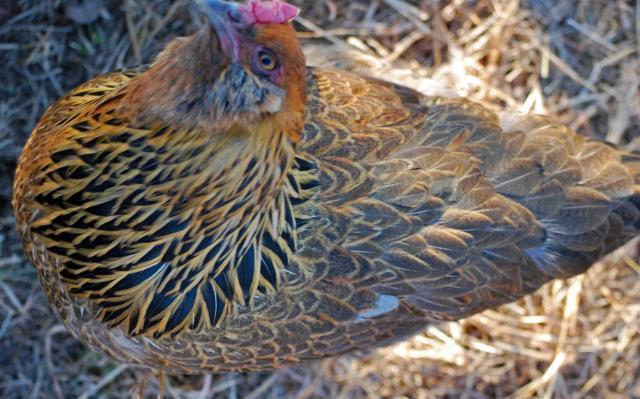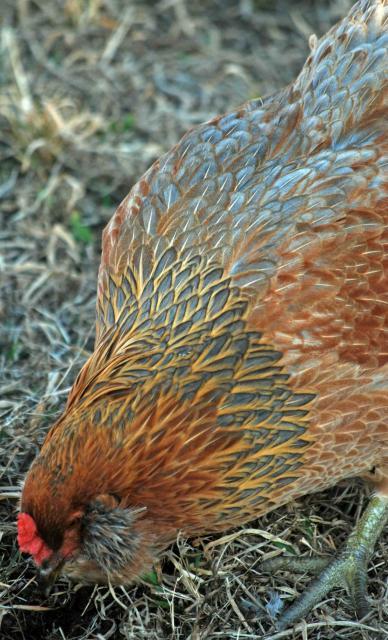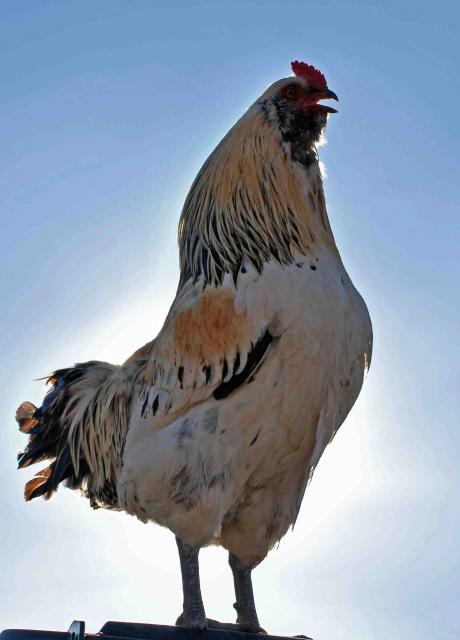Just giving out bit of informative, umm, information
The "wild partridge" look often found on Easter Eggers is simply duckwing, or otherwise called, black breasted red. However, some of them have Columbian in them, too, which causes the males to have all that white on the chest and the pretty gold, red, and black here and there. A good way to find out and track down columbian lines vs straight, original wildtype duckwing lines is not only the rooster's color, but also by looking at the hens. . .
The last brown hens
Medicine Man has been showing are girls with Columbian. Instead of all those neat patterns all throughout the body, the breast and down to the thighs is a solid brown, and in silvers, a solid white color. This is always a really good indicator of columbian present. Also, most of them lack the gold in the neck.
Kassaundra shows some nice examples of straight duckwing.
The second photo shows a normal BBR/duckwing color, like found on the original Quechua. Notice the slight patterning on the chest, and the patterning of salmon, gold, orange, brown, and black all throughout.
Here's another example of columbian in duckwing. These are my own Easter Eggers, crosses of (
columbian) Duckwing Araucana and normal brown egg layers.
Notice, she's got the normal partridgey patterning on the top, but no gold in the neck, and her breast is completely clear of black.
Here's a silver version. She is just gorgeous now (these are old images) as she looks a quarter silver laced, quarter silver partridge, then half solid white.
If she were to be straight duckwing without the partridge, she'd have a pretty salmon breast and coloring running down her neck, too.
And, now the boys. . . This was a nice little lesson for myself. When I first had a good look at the color varieties of EE males, I saw the common trait of a bunch being white breasted with black/gold hackles and saddles and red in the shoulders. Since my first EE cockerel was like this, but he had dominant white which caused the white markings, I thought ALL of them were simply that. . . But it didn't make sense to me, because if it were so, people would be buying far more red pyle colored EE hens. . . And really, those are kind of rare. So after my own little EE breeding tets, I figured it out. . . .
This here is a Golden Duckwing with columbian. And blue. If it weren't for the blue, he'd like like your run of the mill colorful EE rooster. And look, he's got white but absolutely no white genes. . . The answer is in the Columbian. Although in the females it doesn't look that much different, in the males it
reverses the colors. Instead of a black breast and silver or red hackles/saddle, they have a white or red breast, and black or golden hackles/saddle. So, what this guy is showing is "golden" (both gold and silver)
And this guy. . . Is the solid gold version. Without a tail. He's yet to grow out his color in the photo, but he ended up a red with black hackle, saddle, and secondary feathers.
So, here's a tip for anyone curious. . .
If you want more wildtype coloring like Kaussandra showed, one big key is to actually
not breed those pretty white and gold looking roosters. Instead, look for ones with black breasts. Oh and of course, the beautiful gray she showed on her hens, that's the blue gene. . . It is dominant, and if crossed to a normal black patterned bird, will give 50/50. If you cross two birds with the blue color, you also get a 25% chance of splash, a very showy, very beautiful light grayish whitish color. If it is solid, it will make the bird look like a dalmation. If on duckwing colors, it will instead of having gray patterns, have powdery whitish blue patterns.




















